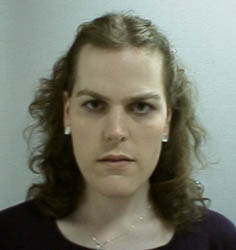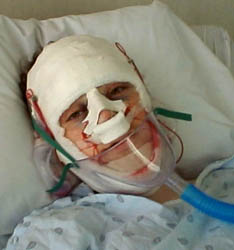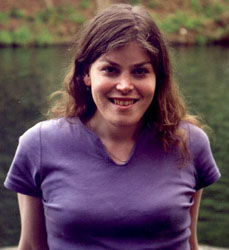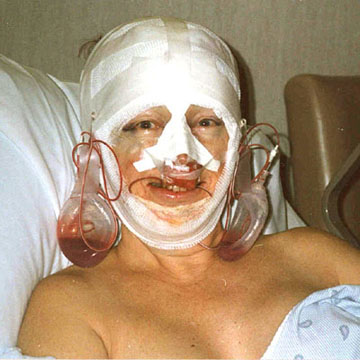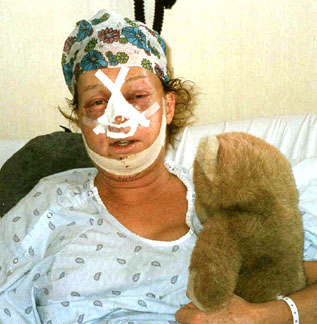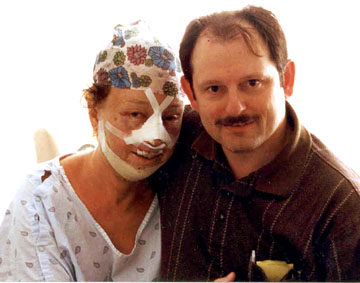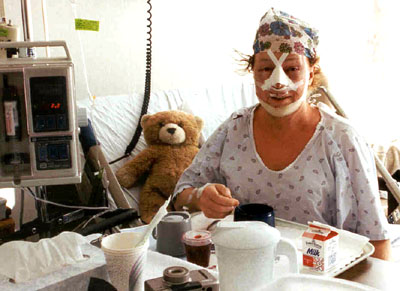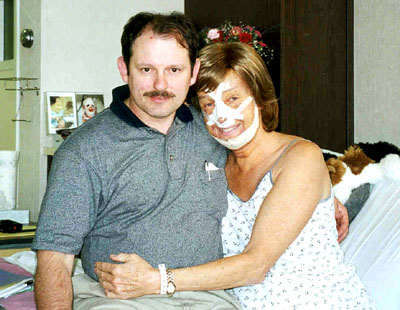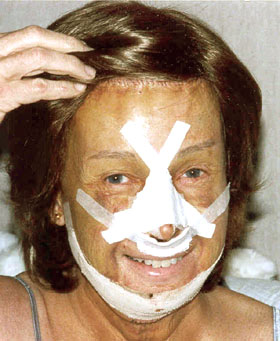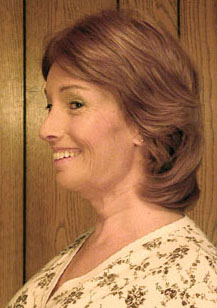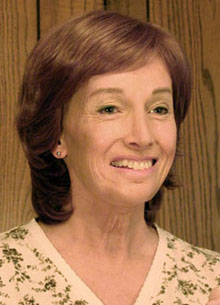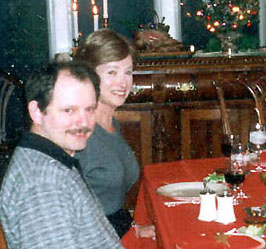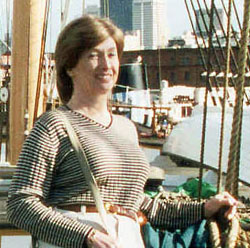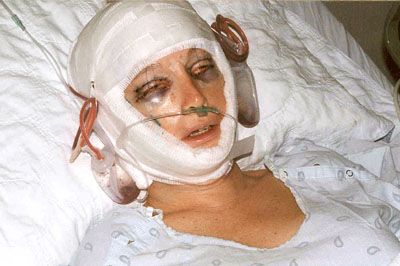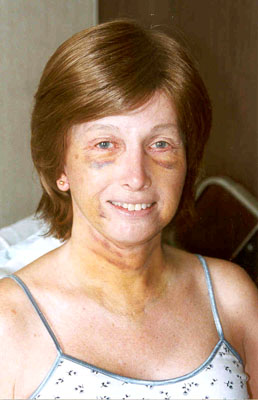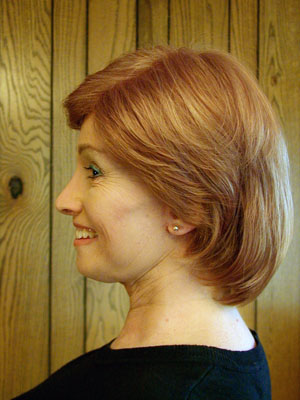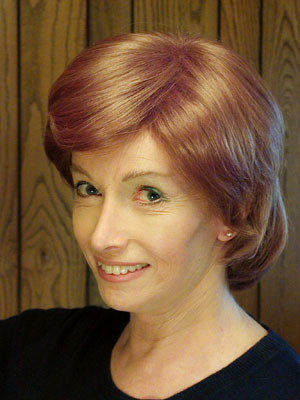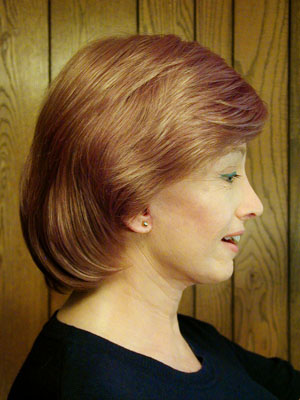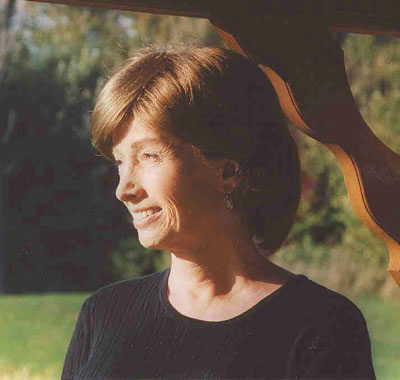|
Lynn et la
Chirurgie de Féminisation du visage (FFS)
Copyright © 2000-2010, Lynn Conway. All Rights Reserved [version of 10-20-10]
Traduit par Marie-Noëlle Révisé par Nathalie
(Anglais)
|
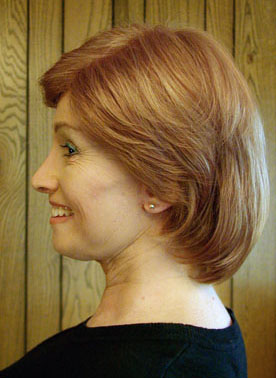 |
|
|
Le 10 novembre 1999, Lynn Conway a bénéficié d'une opération de féminisation du visage (FFS). Cette opération de 10 heures a été réalisée par le Dr. Douglas Ousterhout, M.D, sur le site de Davies du California-Pacific Medical Center de San Francisco. Doug Ousterhout est le chirurgien qui a entrepris le premier cette forme de reconstruction très agressive des os du visage pour les femmes transsexuelles.
Le but de cette intervention est d'éliminer ou de réduire les nombreuses déformations des os causées par les effets masculinisant de la testostérone après la puberté chez les transsexuelles. Pour vous rendre compte de ce qu'il est maintenant possible de faire, vous pouvez découvrir les expériences et examiner les photos avant/après de personnes comme Andrea James, Becky Allison, Gina, Madeleine, Nicki, Sally et Rachel, qui ont toutes été des patientes du Dr Ousterhout. Vous pouvez aussi examiner Diane's page about FFS surgery with Dr. Ousterhout et la page chirurgicale sur le site www.beginninglife.com où vous découvrirez encore plus de témoignages et de liens au sujet de cette opération.
Ces pages contiennent des informations générales, le journal de Lynn et certaines de ses photographies, dans l'espoir que ces informations seront utiles pour les personnes qui envisagent de recourir à ce traitement.
|
|
Durant les années 80, le Dr Douglas Ousterhout comprit que les effets masculinisant de la testostérone chez les transsexuelles (MtF) peuvent être tout aussi défigurant et handicapant socialement que les effets de défiguration chez les victimes d'accidents et chez les enfants qui sont victimes de déformations génétiques du visage. Disposant d'une très large expérience en matière de chirurgie plastique et reconstructive maxillo-faciale et cranio-faciale, et doté d'une large palette de "trucs chirurgicaux" qu'il pouvait appliquer dans de tels cas, le Dr Ousterhout a commencé à pratiquer de nouvelles méthodes très agressives de reconstruction du visage des femmes transsexuelles.
Nombre des techniques chirurgicales utilisées pour réaliser une opération de féminisation du visage sont décrite dans son livre "Aesthetic Contouring of the Craniofacial Skeleton", Douglas K. Ousterhout, Ed., 1991. Ces techniques vont bien au delà de celles utilisées dans le cadre des opérations de chirurgie esthétiques (comme on peut le voir dans les dessins et photos de ce livre qui illustrent l'élimination chirurgicale et la reconstruction d'une large part du front et de l'orbite occulaire afin d'éliminer une arcade sourcilière très masculine).
Dans le cas des femmes transsexuelles, le Dr Ousterhout s'efforce d'ajuster les dimensions du visage à celles qui sont usuelles chez les femmes, sur la base de mesures anthropologiques. Les besoins de la survie au cours de l'évolution ont adapté le visage des hommes pour leur permettre de se protéger durant la chasse et les combats, ce qui leur donne des arcades sourcilières protubérantes et une mâchoire et un menton proéminents. D'un autre côté, le visage des femmes a évolué (tout comme celui des enfants) afin d'améliorer leur capacité à se cacher et à fuir et ayant une vision périphérique moins entravée (avec les yeux plus en avant dans la structure du visage, et sans arcade sourcilière). Ces différences en matière de caractères sexuels secondaires sont induites par des hormones sexuelles présentes en proportions différentes dans le corps des garçons et des filles après la puberté.
Une masculinisation rapide des traits du visage débute durant la puberté et continue durant la vingtaine sous l'influence de la testostérone, qui provoque également l'apparition d'une pilosité abondante et le changement de timbre de la voix. La suppression des sources de testostérone (les testicules) interrompt ce processus comme on peut le voir sur les profils de deux Hijra dont la photo est publiée sur le site de Takeshi Ishikawa (depuis de nombreux siècles un grand nombre de personnes transsexuelles en Inde ont délibérément entrepris des opérations de castration et d'émasculation complète durant leur adolescence, comme rite d'entrée dans la caste des Hijras; Ils vivent ensuite en tant que femmes dans des "familles" Hijras). Les deux Hijras des photos de Takeshi n'ont pas d'arcade sourcilière proéminente, une petite maxillaire et un petit menton, la jointure entre leur front et leur nez est douce. En l'absence de testostérone, les traits de leur visage sont restés ceux qu'ils avaient durant l'enfance et ressemblent bien plus à ceux des autres jeunes femmes (quand bien même les Hijras n'ont d'habitude pas d'accès aux hormones féminines).
Mais qu'est-ce qu'on peut faire pour aider des femmes transsexuelles qui, par la forces des circonstances ont dû grandir dans un corps masculin et ont dû endurer la masculinisation de leur visage? Une féminisation par voie chirurgicale peut être entreprise. Elle redessine le contour du front, elle réduit ou élimine l'arcade sourcilière, elle reconstruit le nez et la liaison avec le front, elle rend plus étroit et réduit la maxillaire et le menton (et le repositionne dans un autre angle), elle redessine la trachée en éliminant la "pomme d'Adam". Cependant, comme pour la chirurgie reconstructive des personnes victimes d'accidents et pour les enfants qui ont des difformités du visage ou un palais fendu, cette chirurgie est extrêmement agressive.
|
||
|
|
|
|
Cependant, dans le cas de personnes transsexuelles pour qui l'arcade sourcilière et la maxillaire sont très protubérantes, l'opération effectuée par le Dr. Ousterhout peut faire la différence entre une vie décente et une mort sociale, c'est à dire entre une acceptation aisée de la personne en tant que femme ou être l'objet d'une stigmatisation massive pour son apparence. Dans de nombreux cas, cette opération remplace un visage qui a toutes les apparences d'un travesti, par des contours féminins et attirants.
Par exemple, considérez le cas de Sally, tel qu'on peut le voir dans les trois photos ci-dessous. La première photo, sur la gauche, la montre alors qu'elle avait encore l'apparence d'un garçon, et d'un beau garçon. La seconde la montre après deux années de traitement hormonal et d'épilation électrique. Nombre de femmes transsexuelles seraient déjà très heureuses d'avoir réussi une pareille transition. Par contraste, nombre de personnes peuvent penser que "maintenant, elle est vraiment bien".
Mais, bien que les traits de son visage soient assez féminins sur cette photo, vous remarquerez qu'elle a encore l'apparence d'un travesti. L'arcade sourcilière protubérante, le grand menton et la maxillaire très évasée qui en faisait un bel homme ruinent son visage en tant que femme. La troisième photo la montre après son opération de reconstruction du visage, par le Dr. Doug Ousterhout. Cette photo met en lumière ce qui ne va pas dans la deuxième et pourquoi elle n'était pas si jolie que ça. La transformation due à l'opération de féminisation du visage est à la fois subtile et profonde. Elle est maintenant une très belle femme, même sans maquillage. C'est un très beau résultat. Toutes les opérations ne seront pas aussi réussies. Cependant, elles permettent souvent de changer la vie, en ce qui concerne la capacité de passer et de l'image que les personnes ont d'elles-mêmes.
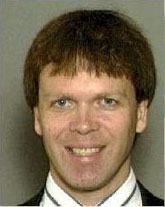 |
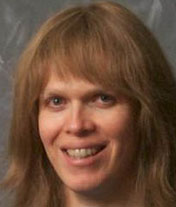 |
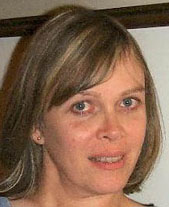 |
Mais que ce passe-t-il ici? Qu'est-ce qui a fait que son apparence a changé à ce point? On trouve la réponse en examinant ce même changement de PROFIL. Bien que nous ne nous regardions presque jamais de profil, c'est souvent dans cette orientation que les autres nous voient. Et c'est la structure de notre visage de profil qui détermine le plus l'apparence de notre visage et le genre qu'on attribue à notre visage, y compris de face. De ce fait, c'est notre profil qui le plus souvent nous donne l'apparence de travestis et nous empêche d'être belles.
Les deux photos qui suivent montrent Sally de profil avant et après sa chirurgie d'opération du visage. Les changements sont vraiment ahurissants. Son profil était vraiment ingrat pour une femme, alors même qu'elle semblait "OK" de face. Après l'opération, son arcade sourcilière proéminente a disparu, et elle a été remplacée par un contour arrondi et féminin. Son nez a été resculpté de manière à se fondre dans le reste du visage. La hauteur et l'angle de son menton ont été radicalement modifiés. La largeur et l'évasement de son maxillaire ont aussi été fortement réduits.
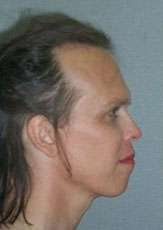 |
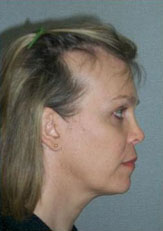 |
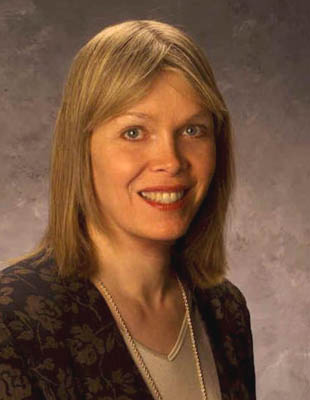 |
"Quand je sortais avant cette opération, quoi que je fasse, quelque soit la joie que j'exprimais, j'étais perçue bizarrement par certains. Je ne parle pas de 'passer' là. Je parle de comment, en tant qu'être humain les gens me voyaient. Je veux très clairement que les gens me voient *moi* sans qu'ils puissent douter de qui je suis. Aussi optimiste et entraînante que je sois avant l'opération du Dr Ousterhout, les lignes et les courbes de mon visage qui n'avaient rien à y faire érodaient ma confiance, étaient aussi déplacés qu'une boucle de cheveux qui se tenait en l'air et que rien n'arrive à ramener sur la tête.
Je suis sûre que si la procédure du Dr. Ousterhout n'existait pas, j'aurais fait au mieux, mais je crains que quelque soit la joie que j'aie amené dans ma vie, la différence entre qui je suis et ce que mon visage disait que j'étais m'aurait consumée. Qui sait.
Le résultat de cette opération ne me permet pas simplement de me déplacer dans le monde et dans la société – ce que j'aurais pu espérer de mieux avant – mais il me permet de l'embrasser, de trouver la paix en moi, ou la possibilité d'y arriver, et les autres le voient et le sentent. C'est un cycle de résonance très précieux en ce sens que mon plus grand confort et ma plus grande relaxation se sentent et que les autres peuvent à leur tour me la refléter."
La réputation du travail du Dr Ousterhout avec les femmes transsexuelles a grandi rapidement depuis le milieu des années 90, quand a été connu le résultat de ces remarquables transformations par ces dernières et par leurs counsellors. L'information s'est répandue encore plus vite à partir du moment où des photos "avant – après" sont apparues sur des sites de personnes transsexuelles, en même temps que des informations sur la manière de se préparer à faire face à cette intervention radicale. Andrea James a été la première femme transsexuelle à publier de telles photos sur son site. Ces dernières ont permis à Nicky, Sally, Lynn et de nombreuses autres femmes de visualiser le principe de cette opération, ce qui les a amenées à décider d'entreprendre cette intervention pour elles-mêmes. En mai 2001, le Dr Ousterhout avait entrepris cette reconstruction majeure du visage sur environ 525 – 550 patientes transsexuelles.
De nombreuses personnes en transition MtF entreprennent maintenant cette intervention juste avant de commencer leur "expérience de la vrai vie". Cette intervention peut grandement augmenter leurs chances de succès durant cette dernière, car elles paraissent encore plus féminines qu'avant. Par exemple, Andrea, Gina, Madeleine, Nicki, Sally and Rachel étaient toutes dans ce cas.
Une meilleure acceptation des personnes durant leur "expérience de la vraie vie" leur permet maintenant de faire leur transition sans changer de place de travail, ce qui les aide aussi à conserver leurs revenus au moment où elles se préparent à leur opération de réattribution de sexe. Bien qu'une intervention de féminisation du visage soit coûteuse, le fait d'éviter de perdre son revenu peut largement compenser cette charge. De plus, nous savons maintenant que ces coûts peuvent être déduits des impôts (aux USA, ndt) car ils sont maintenant considérés comme faisant partie de l'ensemble de l'intervention de réattribution de sexe et non comme une intervention cosmétique.
Les bureaux du Dr Ousterhout se trouvent sur le campus de Davies du California-Pacific Medical Center. Son adresse est la suivante: Douglas Ousterhout, M.D., D.D.S., 45 Castro Street, Suite 150, San Francisco, CA 94114; telephone: (415) 626-2888; e-mail link.
Si vous souhaitez fixer un rendez-vous avec le Dr Ousterhout, téléphonez à son bureau et demandez à parler à son assistante Mira Coluccio. Pour plus d'informations sur le Dr Ousterhout et sur ses méthodes chirurgicales, veuillez consulter la référence suivante: http://www.drdouglasousterhout.com/Cependant, elle n'a jamais oublié les effets terrifiants de masculinisation de son visage qui se sont produits à la fin de son adolescence, alors même qu'ils étaient bien moindres dans son cas que ceux que subissent nombre de transsexuelles. L'opération moderne de féminisation du visage lui a permis de remonter le temps et d'effacer l'essentiel des conséquences de cette horrible expérience. Elle a donc entrepris cette intervention pour pouvoir vivre encore mieux et pour un plus de confort et de bonheur alors qu'elle prend de l'âge.
L'intervention de féminisation du visage de Lynn comprend un avancement de la naissance des cheveux, un changement de la forme du front, l'élimination de l'arcade sourcilière, un changement de position des sourcils, une reconstruction du nez, une reconstruction du menton et de la maxillaire et une réduction de la trachée, le tout en une seule intervention universellement connue sous le nom de "les travaux" parmi les patients du Dr Ousterhout. Les résultats sont à la fois subtils et effarants. Lynn "ressemble toujours à Lynn", en particulier de face. Mais il y a tout une transformation, en particulier quand on la voit de profil. Lynn ressemble maintenant beaucoup plus à ce qu'aurait été sa s?ur jumelle si elle en avait eu une.
Lynn espère que les informations et les expériences décrites ici pourront aider celles qui désirent entreprendre cette intervention. Si c'est votre cas et que vous avez d'autres questions, vous pouvez contacter Lynn par courriel à son adresse ou depuis sa page d'accueil. Elle espère également maintenir cette page aussi à jour que possible. Si vous souhaitez lui faire un feedback, apporter des corrections ou des suggestions, s'il vous plaît, contactez là.
Pour plus d'informations au sujet de Lynn, y compris nombre de photos plus anciennes, consultez sa page d'accueil à:
Ce dernier inclut des articles des médias au sujet de sa vie et de sa carrière à: http://ai.eecs.umich.edu/people/conway/Media/Media.html
J'ai aussi cherché des informations concernant les opérations du visage dans les sites web d'autres transsexuelles et je suis tombée sur les photos stupéfiantes du site d'Andrea. En examinant les photos avant/après d'Andrea et de quelques autres, en particulier de profil, j'ai commencé à comprendre combien les caractéristiques de l'arcade sourcilière, de la maxillaire et du menton affectent le genre attribué à une personne, et en particulier aux femmes transsexuelles. En un instant, j'ai compris l'idée d'une chirurgie de féminisation du visage et combien la nouvelle procédure du Dr Ousterhot était performante.
Lors d'un voyage en Californie, en juin 1999, j'ai rendu visite au Dr Ousterhout pour une consultation et pour savoir ce qu'il pourrait faire pour moi. J'avais suivi les instructions de Mira et j'avais fait faire des photos aux rayons X de mon visage la veille, dans un laboratoire de San Francisco. Le Dr Ousterhot les a alors examinées en même temps que mon visage, en même temps que nous discutions des possibilités. J'ai écouté attentivement ses recommandations initiales, pendant lesquelles il fait une esquisse sur les photos aux rayons X pour me montrer ce qui pouvait être fait avec mon front, mon nez, mon arcade sourcilière et mon maxillaire. Quand j'ai compris à quel point il pouvait les améliorer, j'ai commencé à envisager sérieusement d'entreprendre cette intervention. Après être rentrée à la maison, j'ai contacté plusieurs patientes par e-mail pour connaître leur expérience et les résultats de leurs interventions.
Au milieu du mois de juillet, j'étais décidée à entreprendre cette intervention. J'avais de toute manière besoin d'un lifting et il était maintenant tout à fait clair pour moi que ce serait une immense erreur de le faire sans procéder à une reconstruction de ma structure osseuse en premier. Sans cela, les bénéfices de l'intervention seraient annulés si je devais pratiquer l'intervention de féminisation du visage plus tard.
Avec les années, j'ai subi de nombreuses interventions et il était clair après avoir lu les témoignages des autres patientes que cette opération serait une vraie épreuve comparée aux autres expériences. Elle allait être clairement plus difficile qu'une intervention typique de réattribution de sexe. Mais j'avais aussi appris que tant que vous êtes prêtes à faire face à la douleur et au traumatisme, et pas démolie intérieurement par eux, les mauvais souvenirs s'effacent rapidement. Dans ce cas, les bénéfices dépassent largement le prix à payer.
Je suis retournée chez le Dr Ousterhot en août 1999 pour une consultation détaillée. Nous avons décidé de faire l'ensemble du "travail", c'est à dire l'ensemble des interventions en une seule opération. Il l'a planifiée pour le 10 novembre de la même année. J'ai payé mon dépôt, ce qui confirmait ma décision.
Entre août et octobre, j'ai eu la chance de rencontrer Sally et Nicki, deux femmes qui avaient déjà bénéficié de la même opération avec le Dr Ousterhot. J'étais stupéfaite de la différence que cette intervention avait produite et j'ai appris beaucoup de choses d'elles au sujet de l'intervention et de la récupération. Cela incluait nombre de trucs pratiques au sujet des préparatifs, ce qu'il fallait prendre, les problèmes logistiques, les questions pratiques concernant l'hôpital et le voisinage et de nombreuses informations au sujet de ce qui se passe durant la phase postopératoire.
Par exemple, sur la base des informations que j'avais collectées sur le web et de mes entretiens avec Sally et Nicky et d'autres patientes, j'ai commencé à me préoccuper de la claustrophobie due au fait que je devais porter un bandage sur mon visage pendant cinq jours à cause de mon nez. Je me suis rassurée en m'entraînant un peu à l'avance: j'ai mangé un repas et dormi pendant une nuit en portant des clips qui bouchent le nez pour la nage. Manger et boire furent difficiles, c'était aussi difficile d'avaler et mes oreilles bourdonnaient tout le temps. Mais je m'y suis progressivement habituée, même si c'est resté problématique. J'ai commencé à sentir que les bandages ne seraient pas insupportables.
Au moment où je préparais mes bagages, pensé à ce qu'il fallait prendre et planifié tous les aspects pratiques du voyage et de la récupération, je consultais intensivement les sites d'autres patientes. Il y avait de nombreuses petites questions dont je ne connaissais pas la réponse et d'autres dont je ne savais pas qu'elles devaient être posées. J'ai donc décidé de faire un journal et de prendre des notes à partager avec les autres.
[Note: certaines des photos ci-dessous sont assez spectaculaires. Je les ai inclues de manière à ce que des patients potentiels puissent bien voir à quoi ils vont ressembler peu après l'opération. J'espère que cela va réduire le choc initial du premier regard dans le miroir]
Les chambres d'hôtes étaient pratiques et proches du cabinet du Dr Ousterhot. Il y avait cependant des inconvénients – certaines patientes s'y sentaient très seules. D'autre part, la nourriture hospitalière n'était pas du goût de tout le monde. En décembre 2000, les chambres d'hôte ont été récupérées par l'hôpital et les collaborateurs du Dr Ousterhot ont trouvé une solution pour la récupération et le séjour des personnes opérées. Cette solution est mise en ?uvre par deux infirmières de l'hôpital de Davies. Voici le courriel envoyé par Marie-Lou, l'une des tenancières de la "Cocoon House", pour annoncer sa création:
"Lynn, je me présente (Mary-Lou) ainsi que ma partenaire Tricia. Nous sommes des infirmières qui travaillons dans le bloc opératoire de l'hôpital de Davies. Après avoir appris la fermeture des chambres d'hôte, nous avons décidé de transformer nos deux unités en lieu d'accueil pour les patientes du Dr Ousterhot. Notre but à toutes les deux est de mettre à disposition un environnement non fumeur, confortable, sûr et accueillant. Nous ne fournissons pas de soin infirmier! Mais nous sommes des infirmières qui se soucient de leurs patients! (*) Nous fournissons des repas qui conviennent à des patients qui récupèrent d'une opération de féminisation du visage, c'est à dire des jus, de l'eau, des gélatines, des puddings, des coupes de fruits, des soupes, des popcicles. Chaque chambre est équipée avec une télévision, une vidéo, une stéréo et un lecteur CD, un téléphone (pour des appels locaux uniquement), un réchaud à gaz, un frigo, un four microonde, une machine à café, un sèche-cheveux et un coffre fort pour les objets importants. Nous avons une belle cour avec des citronniers! Notre maison d'hôtes est éloignée d'environ 1 mile de l'hôpital, le système de transports publics est pratique (coût $1.00). Le voisinage (Noe Valley) contient de nombreuses communautés et il est culturellement varié. Contrairement à l'essentiel de la zone de San Francisco, notre environnement est plat! Des restaurants, des épiceries et la plupart des facilités sont très proches de notre résidence. Meilleures salutations, Mary-Lou"
((*) jeu de mots intraduisible: "We do not provide any nursing care!!! We are nurses who care!!!")
Pour environ $125 par jour, la nouvelle "Cocoon House" est une superbe résidence, les repas et la disponibilité du personnel est très précieuse durant la phase de récupération. C'est une très bonne solution. Contactez Mira dans les bureaux du Dr Ousterhot pour plus d'informations et pour réserver une place pour votre séjour.
Dans le journal ci-dessous, je décris mon expérience, qui inclut un séjour dans l'ancienne maison d'hôtes de l'hôpital de Davies. Ceux qui entreprendront cette même opération à l'avenir ne devraient pas oublier que le séjour à la Cocoon House (ou dans un motel) sera différent. Pour plus d'informations à ce sujet, veuillez consulter le site web de Cocoon House.
LINKS TO FURTHER FFS INFORMATION:
Since this page was first posted in 2000, ever-increasing numbers of trans women have been undergoing FFS in order to more smoothly and successfully complete their gender transitions. As a result, a number of prominent plastic surgeons around the world have begun doing the type of facial surgery pioneered by Douglas Ousterhout, and are becoming experienced in these surgeries. More and more women are posting their stories and photos of FFS results as each year goes by, thus helping other transitioners better understand the cost/risk/reward tradeoffs involved in undergoing these surgeries. All this activity has led to ever-more information about FFS being posted on the internet. The following links will help you begin to explore all that information:
Andrea James' FFS information page, with links to many FFS information resources.
Diane's page about her FFS surgery with Dr. Ousterhout.
Facial Feminization Information.
Vicki Estrada's photo-diary video about her Facial Feminization Surgery with Dr. Spiegel in Boston NEW
Victoria Escher's page about her FFS with Dr. Ousterhout (including before/after photos) NEW
Prominent FFS surgeons' websites:
Douglas Ousterhout, M.D., San Francisco, CA
Jeffrey Spiegel, M.D., Boston, MA (link to FFS page, also see many photos at this link)
Mark L. Zukowski, M.D., Chicago, IL
Frans Noorman van der Dussen, M.D., Antwerp, Belgium
Suporn Watanyusakul, M.D., Chonburi, Thailand
Bart van de Ven, M.D., Ghent, Belgium (procedures, before/after photos,) NEW
Marcelo Di Maggio, M.D., Buenos Aires, Argentina (more, more, more, more, more, more) NEW
REMERCIEMENTS:
Tous mes remerciements au Dr Douglas Ousterhout pour sa compréhension et son souci quant aux conséquences de la défiguration du visage des femmes transsexuelles, pour appliquer ses capacités d'innovation et de création à la résolution de ce problème et pour faire bénéficier son habileté chirurgicale sans pareil à la féminisation des visages de tant et tant de femmes transsexuelles.
Merci à sa gestionnaire et assistante, Mira Coluccio, qui entre en relation étroite avec toutes les patientes pour les aider à se préparer et qui les aide à faire face aux difficultés de la récupération, et qui se charge de faire en sorte que l'entreprise chirurgicale du Dr Ousterhout fonctionne sans heurt. J'aimerais également remercier Andre James, Sally, Nicki, Jessica et Carolyn pour toute l'aide qu'elles m'ont donnée personnellement et alors que je préparais ce site web.
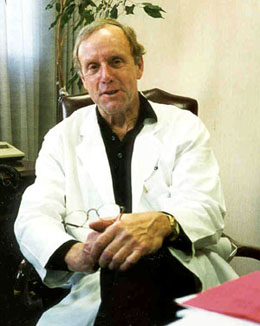 |
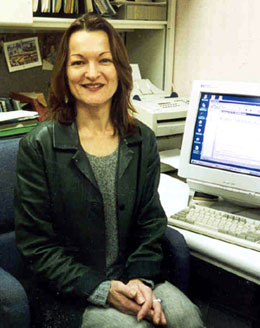 |
Note: ici se termine la traduction partielle de cette page. Elle inclut une description de l'opération de féminisation du visage. Le reste de la page (l'agenda et les informations au sujet de l'hôpital et des facilités de logement) est, pour l'instant, uniquement en anglais.
